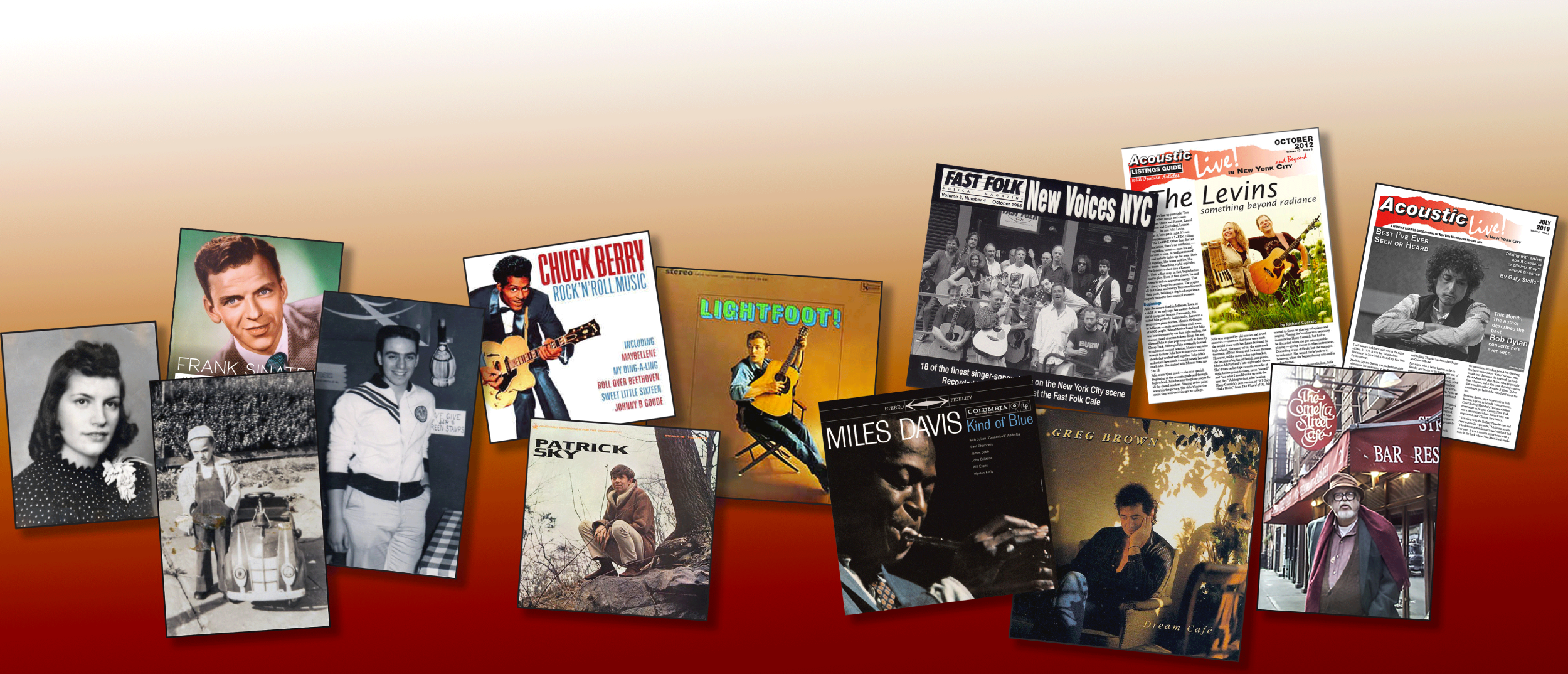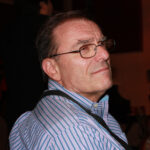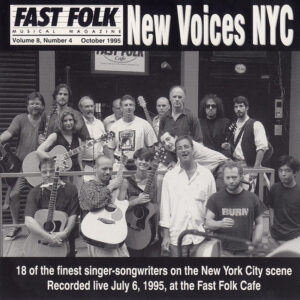
Richard Cuccaro
I was born in 1941. I’ve been a music fan since I was a toddler. My mother, an aspiring singer, had the radio on almost constantly. I’d hear big bands and crooners on Martin Block’s “Make Believe Ballroom” daily. After hearing my mother sing around the house, I began to sing songs I heard on the radio. Mom drove us to a tiny local recording studio and we both recorded songs. My versions of “The Old Lamplighter” and “For Me and My Gal” would provide many minutes of embarrassment when played during family gatherings.
In the early 50s, Doo-wop and Rockabilly totally blew up the airwaves just as I was reaching puberty. The impact was like an earthquake. Chuck Berry, Elvis Presley, Jerry Lee Lewis, Gene Vincent and The Blue Caps, Little Richard and Fats Domino were a major part of my personal life soundtrack.
It wasn’t until the late ’50s and early ’60s that I began listening to folk music. The Kingston Trio led the way for Peter, Paul and Mary and then Bob Dylan. The floodgates opened and Dave Van Ronk, Patrick Sky, Buffy Sainte Marie and many others followed.
Folk and folk/rock were everywhere and I wanted to be part of it. I was studying Industrial Design at the University of Bridgeport, (Conn.) in the early ’60s. One of the professors, Will Tressler, was a folk musician who held hootenannies in the barn adjacent to his house in nearby Easton. I took guitar lessons from him and attended every “hoot,” sometimes playing what I learned from him. I was particularly entranced with the blues and learned “The Midnight Special” before moving on to songs like Fred Neil’s “Blues on the Ceiling.” As part of a duo, I also tinkered with some Jim Kweskin Jug Band material.
All the while, The Beatles, The Rolling Stones, Cream, Led Zeppelin and the rest of the British Invasion were imprinting the walls of my brain with pop, revived blues and psychedelia. Much later, it occurred to me that, without Howlin’ Wolf, there might have not been a Mick Jagger. Here at home, The Byrds, The Jefferson Airplane, Simon and Garfunkel, Buffalo Springfield and the Beach Boys were holding up their end.
My post-college years found me leaning toward jazz. Miles Davis, Cannonball Adderley, John Coltrane and Wes Montgomery were favorites. Later, primarily in the ’80s, I became heavily invested in jazz fusion. Chick Corea, Jean Luc Ponty and Pat Metheny were among my favorites.
This all changed in the early ’90s. Fordham Radio WFUV-FM in the Bronx (NY) had a program called “Cityfolk.” I began hearing songs by Greg Brown, Richard Thompson, Patty Larkin, Cliff Eberhardt, Lucy Kaplansky, Richard Shindell and Shawn Colvin. I became fascinated with the singer/songwriter genre.
One night, on WFUV, Fast Folk Musical Magazine founder, Jack Hardy, was interviewed. He talked about his new folk club, the Fast Folk Cafe that would soon open in Tribeca and also promoted the annual Fast Folk show at the Bottom Line nightclub the next night. I attended the show and was in Tribeca a couple of nights later to help put the finishing touches on the performance space.
 I began volunteering at the cafe for every show, setting up and doing clean-up afterward. Jack held song swaps at his Greenwich Village apartment every Monday. My guitar-playing, songwriting desire rejuvenated, I began attending. I also began playing on open mic nights. One of my songs, “Hattertown Road,” was included on a Fast Folk “New Voices” CD. The author can be seen at lower left on the cover, hiding behind his guitar.
I began volunteering at the cafe for every show, setting up and doing clean-up afterward. Jack held song swaps at his Greenwich Village apartment every Monday. My guitar-playing, songwriting desire rejuvenated, I began attending. I also began playing on open mic nights. One of my songs, “Hattertown Road,” was included on a Fast Folk “New Voices” CD. The author can be seen at lower left on the cover, hiding behind his guitar.
When Jack needed to go back out on tour, I joined forces with other volunteers to keep the cafe going. Eventually, I took on the role of volunteer cafe manager. We began putting on shows five or six nights each week. For 2 1/2 years I was at almost every show and became acquainted with perhaps 100 or more singer/songwriters. Regrettably after those 2 1/2 years, I experienced burnout and let another volunteer take the helm.
The burnout didn’t last long. Within one year, a brainchild dominated my thoughts. As a computer graphics artist, I could create a bulletin, photocopy it and promote the performers who had inspired me at the Fast Folk Cafe.
At first, I thought I’d compile shows for as many performers as possible, print the list and distribute it monthly. I realized pretty quickly that the idea was impractical. It would be better to arrange performances by venues within areas around New York City. This would encompass a wide range of performers, staying within the confines of the New York Tri-state area. I also wanted to highlight certain artists and decided to feature one every month.
I published the inaugural issue on June 1, 1999. The cover story profiled then-local performer Steve Tannen, whose voice I found spellbinding. He later became, with his wife Deb Talan, one-half of the internationally-known pop-folk duo, The Weepies.
 While many of the early cover stories profiled artists based in New York City, national touring performers have also been included. These include Eliza Gilkyson, Tom Russell, Catie Curtis, Cosy Sheridan and Jorma Kaukonen. We’re proud to have interviewed folk icons such as Pete Seeger (https://acousticlive.com/August_2008.html) and Dave Van Ronk (https://acousticlive.com/January_2001.html). Dave is seen here outside the Cornelia Street Cafe, where I interviewed him approximately one year before he passed away.
While many of the early cover stories profiled artists based in New York City, national touring performers have also been included. These include Eliza Gilkyson, Tom Russell, Catie Curtis, Cosy Sheridan and Jorma Kaukonen. We’re proud to have interviewed folk icons such as Pete Seeger (https://acousticlive.com/August_2008.html) and Dave Van Ronk (https://acousticlive.com/January_2001.html). Dave is seen here outside the Cornelia Street Cafe, where I interviewed him approximately one year before he passed away.
I published the newsletter/listings guide as a homemade printed newsletter, distributed by hand to local Manhattan venues and mailed in small packets to Westchester, upstate New York, New Jersey and Connecticut coffeehouses. This continued until financial restrictions caused a shift to a web-only presence. For those who still want a sheet they can read from, a subscriber/presenter/media-only link to a printable pdf is still sent monthly.
.
From the beginning, all issues were also available online. Our website, acousticlive.com, began posting in 1999. The web platform used to create it is now outmoded so it now functions as an archive while we rebuild, using acousticlivenytsa (nytsa = New York Tri-state area).
